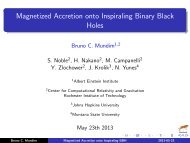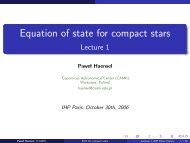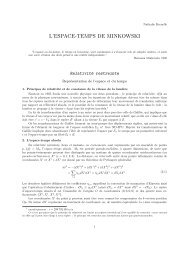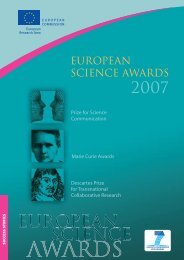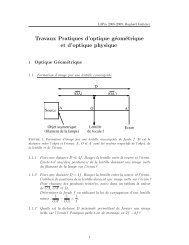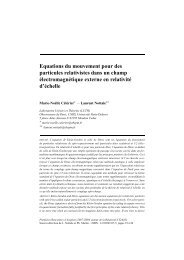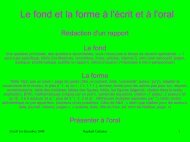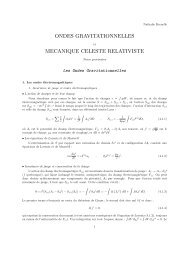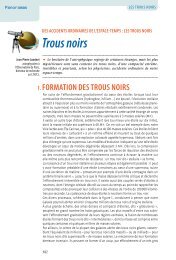J. Phys. A: Math. Gen. 32 (1999) - LUTH - Observatoire de Paris
J. Phys. A: Math. Gen. 32 (1999) - LUTH - Observatoire de Paris
J. Phys. A: Math. Gen. 32 (1999) - LUTH - Observatoire de Paris
Create successful ePaper yourself
Turn your PDF publications into a flip-book with our unique Google optimized e-Paper software.
2876 J-C Pisson<strong>de</strong>s<br />
In stochastic mechanics, the expectation is taken on a previously <strong>de</strong>fined probability <strong>de</strong>nsity.<br />
Here, though it has yet to be rigorously <strong>de</strong>fined, the expectation would concern the infinite set<br />
of geo<strong>de</strong>sics. Once applied to x µ , they yield the forward and backward mean four-velocities<br />
d+<br />
d−<br />
ds xµ (s) = v µ +<br />
ds xµ (s) = v µ<br />
−. (3)<br />
As in the non-relativistic case [1], the forward and backward <strong>de</strong>rivatives (3) can be combined<br />
in terms of a complex <strong>de</strong>rivative operator [9]<br />
d<br />
ds ≡ (d+ +d−)−i(d+−d−)<br />
. (4)<br />
2ds<br />
When applied to the position vector, it yields a complex four-velocity<br />
V µ ≡ dxµ<br />
ds = vµ + + v µ<br />
−<br />
− i<br />
2<br />
vµ + − v µ<br />
−<br />
= V<br />
2<br />
µ − iU µ . (5)<br />
Let us now jump to the stochastic interpretation of the theory. This leads us to consi<strong>de</strong>r the<br />
question of the <strong>de</strong>finition of a Lorentz-covariant diffusion in spacetime. Forward and backward<br />
fluctuations, dξ µ<br />
±(s), are <strong>de</strong>fined, which are Gaussian with mean zero, mutually in<strong>de</strong>pen<strong>de</strong>nt<br />
and such that<br />
〈 dξ µ<br />
± dξ ν ± 〉=∓ληµν ds. (6)<br />
In this paper, we choose a (+, −, −, −) signature. It is not the purpose of this article to examine<br />
the difficulties which appear when we consi<strong>de</strong>r stochastic processes in the relativistic case, but<br />
as has been pointed out by Hakim [16], we cannot naively transpose to the relativistic case<br />
the usual classical <strong>de</strong>finitions of stochastic processes. Several authors have consi<strong>de</strong>red the<br />
extension of Nelson stochastic mechanics to the relativistic case and have introduced some<br />
specific notions to achieve as fairly as possible this extension. We may mention [17], where<br />
Dohrn and Guerra introduce two metrics; a ‘Brownian metric’ η µν , which is positive <strong>de</strong>finite<br />
and which is present in the expectation 〈 dW µ dW ν 〉∝η µν dτ of the stochastic process dW µ ;<br />
and a ‘kinetic metric’ gµν, which is used to write the kinetic term (1/2)gµνv µ + vν − in a stochastic<br />
Lagrangian. The compatibility condition between these two metrics reads gµνη µρη νλ = gρλ .<br />
We also refer the rea<strong>de</strong>r to the work of Zastawniak [18] and finally to Serva [19], who gives up<br />
Markov processes and consi<strong>de</strong>rs a covariant process that belongs to a larger class, known as<br />
‘Bernstein processes’. We do not claim here to end the discussion about relativistic stochastic<br />
processes, but we may keep in mind that the role played by the Laplacian operator in the<br />
non-relativistic case, is now played by the Dalembertian operator in the relativistic equations.<br />
So, we can show that the two forward and backward differentials of a function f(x,s) are<br />
written, assuming a Minkowskian metric (+, −, −, −) for classical spacetime:<br />
d±f<br />
ds =<br />
<br />
∂<br />
+ vµ ±∂µ ∓<br />
∂s λ<br />
2 ∂µ <br />
∂µ f. (7)<br />
In the following, we only consi<strong>de</strong>r s-stationary functions, i.e. functions that do not<br />
explicitly <strong>de</strong>pend on the proper time s. In this case the time <strong>de</strong>rivative complex operator<br />
finally reduces to [9]<br />
d<br />
ds = Vµ ∂µ +i λ<br />
2 ∂µ ∂µ. (8)<br />
Note the correction of sign with respect to [9]. The + sign of the Dalembertian comes from<br />
the choice of a metric signature (+, −, −, −) for the classical spacetime.<br />
Following [4, 9], the operator (8) would play the role, in the relativistic case of motion,<br />
ofa‘scale-covariant <strong>de</strong>rivative’. Therefore, we assume that the equations of motion of a free<br />
relativistic quantum particle, may be written as<br />
dV α<br />
ds<br />
= 0 (9)



